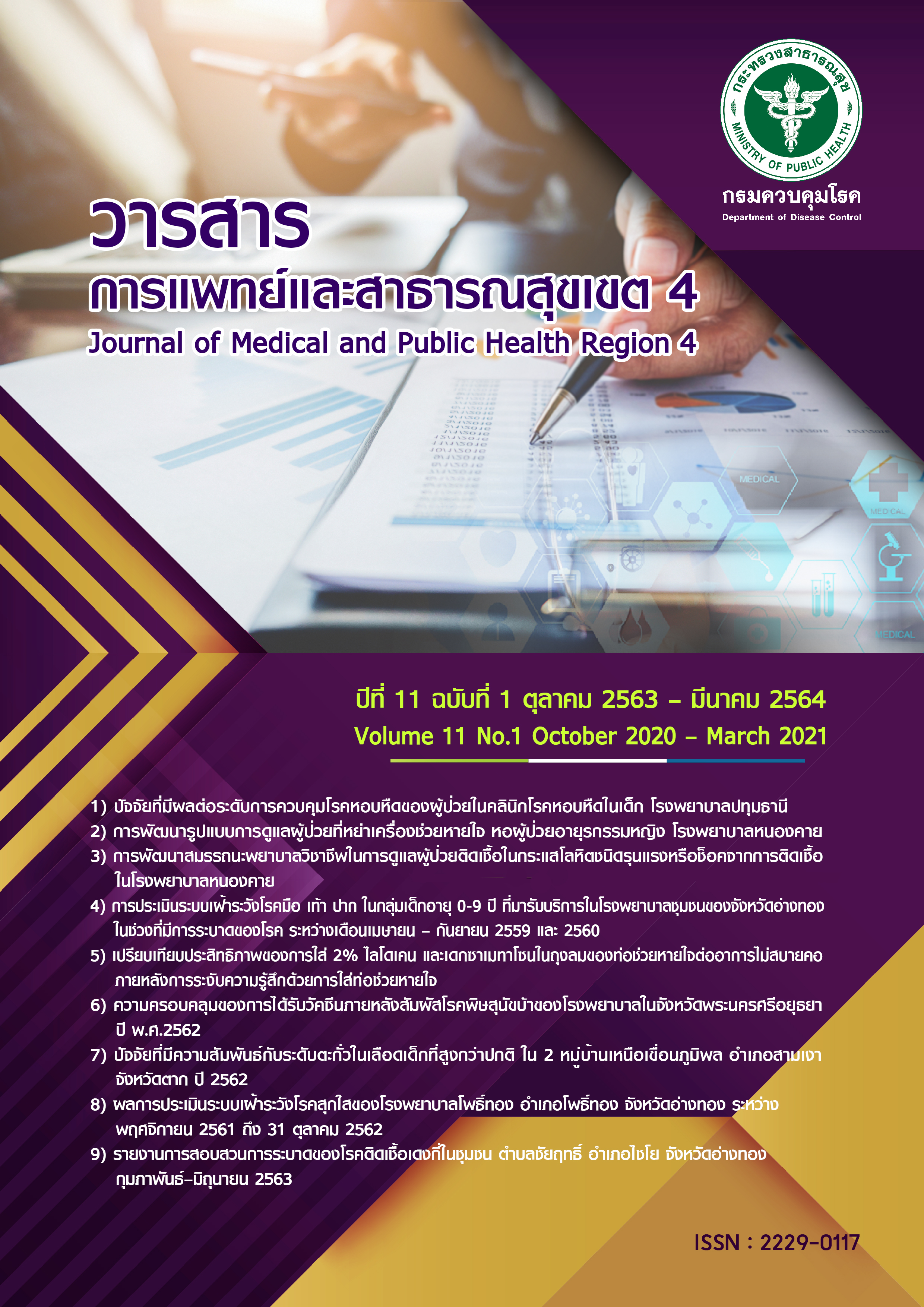Factors associated with elevated blood lead levels among children in two villages at reservoir of Bhumibol Dam, Sam Ngao district, Tak province, 2019
Main Article Content
Abstract
Blood lead level has widely been used to indicate lead exposure in humans. This report presents blood lead levels (BLLs) and factors associated with elevated BLLs (> 10 µg/dl) among children aged 1-14 years old in two villages at reservoir of Bhumibol Dam, Sam Ngao District, Tak Province, 2019. All target children were identified and their parents were interviewed about demographic characteristics and possible lead exposure. Body weight of each participant was measured to determine nutritional status, weight for age. Venous whole blood was collected for measurements of complete blood count and a BLL. Case investigation was additionally carried out among those in the highest BLL group. A total of 101 children were screened for BLLs. The mean age of the study children was about 8.6 years old. The proportions of boys and girls were similar. About 39.6% of the children had BLLs of 5-9.9 µg/dl and 14.9% had ≥ 10 µg/dl. Factors significantly associated with elevated BLLs included being a boy, older age and history of exposure to lead melting. All children with history of lead melting exposure were boys of older age. Children with low weight-for-age had slightly higher BLLs than those with normal/over weight-for-age. Those with anemia had slightly higher BLLs than those with no anemia. It is essential to educate people, particularly school boys, in the areas about lead toxicity, exposure, and prevention, regularly follow-up children with high BLLs, and manage those with low weight for age and anemia.
Article Details
References
2. WHO. Exposure to lead: a major public health concern. Geneva: World Health Organization; 2010.
3. Mahaffey KR. Nutrition and lead: strategies for public health. Environ Health Perspect 1995;103 (Suppl 6):191-6.
4. Bellinger DC. Lead. Pediatrics 2004;113 (Suppl 4):1016-22.
5. CDC. Preventing lead poisoning in young children. Atlanta: US Department of Health and Human Services, Public Health Service, Centers for Disease Control and Prevention; 1991.
6. American Academy of Pediatrics. Lead exposure in children: prevention, detection, and management. Pediatrics 2005;116:1036-46.
7. Advisory Committee on Childhood Lead Poisoning Prevention. Low level lead exposure harms children: a renewed call for primary prevention. Atlanta: US Department of Health and Human Services, Public Health Service, Centers for Disease Control and Prevention; 2012.
8. Swaddiwudhipong W, Tontiwattanasap W, Khunyotying W, Sanreun C. Blood lead levels among rural Thai children exposed to lead-acid batteries from solar energy conversion systems. Southeast Asian J Trop Med Public Health 2013;44:1079-87.
9. Swaddiwudhipong W, Kavinum S, Papwijitsil R, Tontiwattanasap W, Khunyotying W, Umpan J, et al. Personal and environmental risk factors significantly associated with elevated blood lead levels in rural Thai children. Southeast Asian J Trop Med Public Health 2014;45:1492-502.
10. Department of Health, Thailand Ministry of Public Health. Maternal and child health records: growth standards for weight and height for Thai children. Nonthaburi: Ministry of Public Health; 2011.
11. WHO. Worldwide prevalence of anemia, 1993-2005. Geneva: World Health Organization; 2008.
12. WHO. Guidelines for drinking-water quality, 4th ed. Geneva: World Health Organization; 2017.
13. Neesanan N, Kasemsup R, Ratanachuaeg S, Kojaranjit P, Sakulnoom K, Padungtod C. Preliminary study on assessment of lead exposure in Thai children aged between 3-7 years old who live in Umphang district, Tak Province. J Med Assoc Thai 2011;94 (suppl):113-20.
14. Wang JD, Jang CS, Hwang,YH, Chen ZS. Lead contamination around a kindergarten near a battery recycling plant. Bull Environ Contam Toxicol 1992;49:23-30.
15. Ruangkanchanasetr S, Suepiantham J. Risk factors of high lead level in Bangkok children. J Med Assoc Thai 2002;85 (suppl):1049-58.
16. Iriani DU, Matsukawa T, Tadjudin MK, Itoh H, Yokoyama K. Cross-sectional study on the effects of socioeconomic factors on lead exposure in children by gender in Serpong, Indonesia. Int J Environ Res Public Health 2012;9:4135-49.
17. Naicker N, Richter L, Mathee A, Becker P, Norris SA. Environmental lead exposure and socio-behavioural adjustment in the early teens: the birth to twenty cohort. Sci Total Environ 2012;414:120-5.
18. Gao Z, Cao J, Yan J, Wang J, Cai S, Yan C. Blood lead levels and risk factors among preschool children in a lead polluted area in Taizhou, China. Biomed Res Int 2017;2017:4934198.
19. Shakya S, Bhatta MP. Elevated blood lead levels among resettled refugee children in Ohio, 2009-2016. Am J Public Health 2019;109:912-20.


